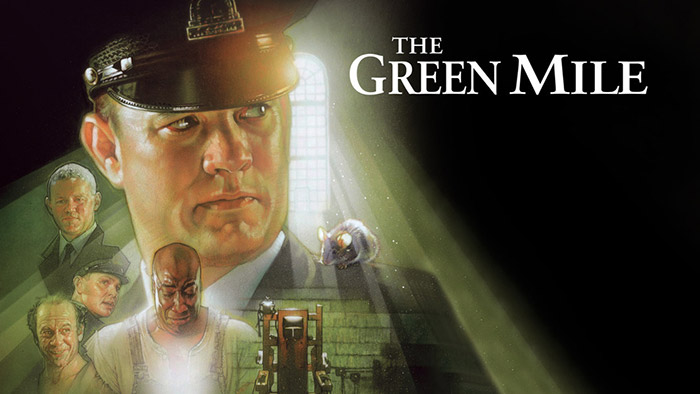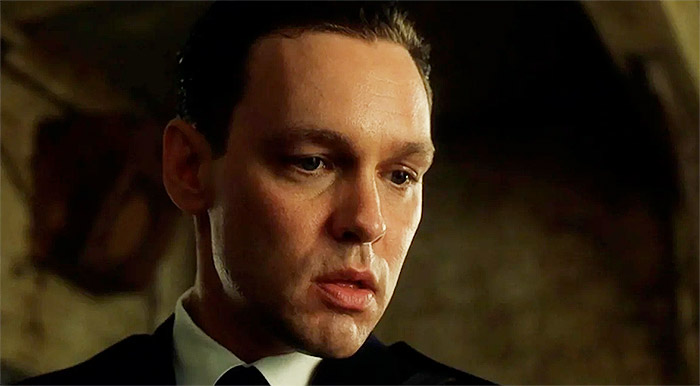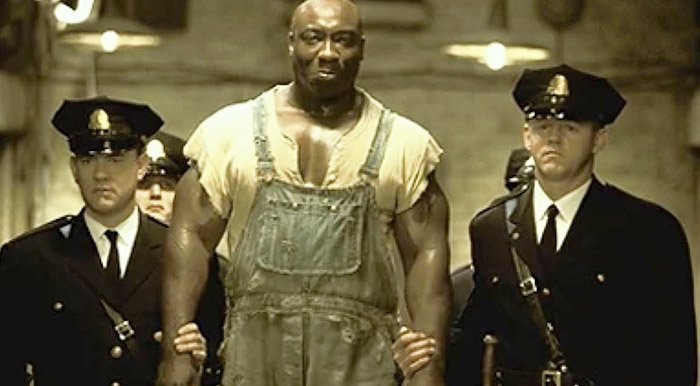The Green Mile: Exploring Emotional Responses

The Green Mile (1998) directed by Frank Darabont’s is about the lives of prison guards on Death Row and how they are affected by one of their charges: a black man accused of child murder and rape, yet who has a mysterious gift. Darabont’s adaptation of Stephen King’s The Green Mile is a film that creates a powerful emotional response through its strong development of characters led by the misunderstood prisoner Coffey. The Green Mile asks the audience to look beyond labels and see the characters as human which are reinforced by the performances of John Coffey (protagonist) and Percy Wetmore (antagonist). Despite its long-running time of three hours, the director states that the long duration is a key technique in ensuring the audience is fully invested emotionally. It can be seen as a technique that is used to allow the audience to gain a full understanding of the characters, giving the director time for characterisation to create more complex audience alignments.
Character Alignment and Emotional Response
The themes of redemption and forgiveness mean that narratively we don’t delve into the prisoner past, but instead, we are able to form close emotional bonds with characters like Coffey and Dale, because of their likeable characteristics. The film centres on the protagonist ‘prisoner’ John Coffey, creating a very powerful emotional response as we see the final run-up to his wrongful execution. Coffey is a protagonist where the audience is invited to sympathise with by being placed in an omniscient position. By being placed in this way we are aware of the character’s innocence which provokes a powerful emotional response as he is executed. The spiritual healing qualities of Coffey symbolise the embodiment of Jesus, making him a likeable character as the audience recognise his sacrifice to take on the negatives of the world to help people. Coffey’s childlike mindset, creates a more sympathetic response, as he is unable to defend himself and invites the need to be protected.

Arguably through performance, the antagonist of the film is Percy the prison guard. He is an antagonist that the audience is asked to despise and feel anger towards. Throughout the film, Percy is seen to be a sadistic bully who gains pleasure from the pain and suffering of others. Percy is seen as weak and cowardly, the negative aspects that manipulate the audience into feeling hatred towards him. Percy is first introduced, as a spoilt character who has gained power through his uncle’s connection and not by hard work or dedication making him unrelatable as traditionally audiences backup the underrepresented character.

During The Introduction to Coffey sequence, the film plays on the misconceptions and stereotypes which blur the lines between protagonist and antagonist. As the sequence resolves the audience is left with no doubt on which character they should emotionally align with. Coffey’s performance in the sequence creates an initial fear within the audience. The cinematography restricts the audience from seeing Coffey’s face which draws attention to his size and builds up a sense of fear and doesn’t allow us as an audience to connect to him or judge him based on his size or skin colour playing into the ideas of the era were black people were viewed negatively. The Reaction shots of the guards and prisoners fear manipulates the audience to share their perspective and villainize Coffey. By the end of the film, Coffey transforms into a character where the audience can immediately sympathise with because of his obedient nature. His use of the word ‘Boss’ gives protagonist qualities as he seems respectful and unthreatening.
The framing of Percy throughout the sequences highlights his inferior complex and fake position of power. Percy is seen framed weaker on the right as he is given orders by Edgecombe and Brutus. However, this is juxtaposed as he is also seen framed on the left when he uses his fake superiority to torment the prisoners. Percy’ performance during the initial meeting is constructed as an antagonist. The tone of Percy’s dialogue as he echoes the words ‘dead man walking’ creates an initial hatred as he abuses his power and finds pleasure in humiliating the prisoner. Percy is the only guard that has his baton out which connotes him as an aggressor who seeks confrontation. His position as an antagonist is confirmed as he sadistically breaks Dale’s fingers.
Surprisingly Coffey transforms into a character the audience immediately sympathise with. The tone of voice of Coffey provokes the audience to sympathise with him as he dialogue trembles showing the fear he has inside him. His obedient nature and use of the words ‘Boss’ hold more protagonist qualities as he seems respectful and unthreatening. ‘Do you leave the light on after bedtime’ paints Coffey as childlike, encouraging the audience to feel sympathy and understand his need for protection? The close up of Coffey at the end sequence manipulates the audience to connect with him as a protagonist and question his presumed guilt. The sequence reinforces the performances of an antagonist and protagonist.
Alternative readings can be applied to Coffey and Percy, as they hold key characteristics, that audiences can question about their performance as protagonist and antagonist. Coffey’s has the power of taking and giving life which the audience could question whether he is suitable for this responsibility. Coffey’s punishment of Percy and Wild Bill can be viewed as going too far as he doesn’t offer the antagonists a chance at redemption. However, redemption is an important theme of the film and is seen as a luxury given to the other protagonists’ prisoners as we are manipulated to forgive them. Alternatively, Percy’s role as an antagonist could be questioned and argued as although cruel he was just carrying out his role as a prison guard and punishing those that deserve it. The segregation of Percy by the other guards could invite sympathy and cause Percy to act the way he does to be noticed.
The setting of The Green Mile and the serious nature of the prisoner’s crimes on death row could be read in an alternative way. We could instead reject Darabont’s manipulation of who we should be forced to align with as Darabont doesn’t explore the serious crimes that they committed. Alternatively, we can view Edgecomb’s treatment as being too fair, as they deserve to be punished. By avoiding the prisoners past it goes against the alternative reading and invites the audience to judge the characters based on their performances. With the narrative taking place predominantly on The Green Mile, it allows us to make our own opinions on the prisoners, and build a positive alignment as we see them as reformed and regretful. Darabont’s uses performance to create a problematic emotional response for the spectator; this technique is specifically designed to confuse and conflict with the spectator’s loyalty and to test their emotional tolerance to popular film.

Cognitive Theory And Audience Manipulation
The Green Mile is a film that takes the audience on an emotional journey manipulating them to feel moments of anger, happiness, frustration and ultimately sadness as the film resolves. This emotional response is also reinforced by the director himself, as Darabont recognises The Green Mile, as a cunningly manipulative film. “Every frame of every movie is an attempt by the artist to manipulate the perceptions or emotions of the viewer. The point is, do you appreciate the manipulation or resent it? Do you notice it, or do you completely, blindly give yourself over to it?” This can be applied to the wider idea of cognitive theory.
Cognitive theory suggests debates over the notion of the unthinking response, a passive spectator whose emotional response is not only shaped, but directed by the filmmaker, suggesting the initial emotional response is impulsive due to how the text is constructed. The Green Mile uses the theme of death to manipulate a passive audience cognitively in feeling strong emotional responses throughout the film. The theme of death provokes a powerful emotional response as it classed as a primal fear that resonates with the audience, as they recognise at some point it will affect them. In the film, death acts as a sense of finality to the characters and could be seen as an easy technique to force an emotional response in the audience.
The film from a passive perspective manipulates the audience to reach a conclusion that views the idea of the death penalty negatively. From a cognitive perspective, the execution of Del creates a great deal of emotional shock within the audience. The film during this sequence lends from the conventions of the horror to provoke a passive audience, using technical and thematic approaches of the genre to ensure the audience feel a sense of fear and uncomfortableness to Del death. By using conventions of horror Darabont automatically builds a sense of fear and tension in the sequence in a passive audience, through their previous experiences in the genre.
The sequence is constructed using the conventions of horror, to manipulate the audience to feel emotional shock. The sequence opens with a long shot of the prison being surrounded by thunder and lightning. The shot visuals match that of haunted house expected in horror, while the weather acts a pathetic fallacy that forebodes the danger and forces the audience to feel tense and fearful. The visual image of Del’s body burning is viscerally disturbing along with pleonastic sounds of him screaming and body burning provokes strong elements of horror body trauma in order to create emotional shock in the audience. The non-diegetic orchestral discordant score parallels that of horror to create tension and fear. The twisted and canted angles of Coffey and wild Bill losing control in their cells mimics the disturbing images of a horror mental asylum.
The Green Mile is a film that is considered to be a tear-jerker that creates a powerful emotional reaction to the films resolution and Coffey’s execution. Theorist Philips states this is a cathartic response and one of the pleasures of film, as the audience can use the events of the film and emotional bond with Coffey to physically purge their feelings. Coffey’s execution creates a cathartic response, reducing the audience to tears through emotional sadness. The audience responds in a cathartic way as they feel extreme sadness as they recognise Coffey as a character who doesn’t deserve to be killed. the audience is manipulated through the technical construction of the sequence to respond in the way the director intended. The non-diegetic orchestral score is used throughout to dictate the audience’s emotions and increases in volume as the execution draws closer to manipulate the audience’s emotional sadness to increase. The shallow depth of field and the close-ups of the teary reactions of Paul and the other guards, asks them to connect with the characters and share their moment of sadness promoting a cathartic response. The slow editing pace of the sequence forces the audience to dwell on the event and the moment of sadness as Coffey is executed. The stumbling tone of voice provokes a strong reaction as we recognise even Edgecombe is unable to hide his emotions.
Religious Themes
The Green Mile is a film that takes the audience on an emotional journey manipulating them to feel moments of anger, happiness, frustration and ultimately sadness as the film resolves. This emotional response is also reinforced by the director himself, as Darabont’s recognises The Green Mile, as a cunningly manipulative film. The Green Mile can be viewed as a drama that incorporates elements of fantasy, through the magical healing powers of John Coffey. However, through additional viewing and engagement with the wider themes, the film creates an alternative viewing context through the appreciation of the religious symbolism throughout. Active spectators may draw comparisons between John Coffey and Jesus.
Looking at the film the predominant connection of religion within the film is through the protagonist John Coffey. Stephen King the original author developed Coffey to become the embodiment of Jesus Christ, even subtly using the same initials JC. We can make comparisons between Coffey and Jesus, which creates a more powerful emotional alignment with the audience. Both Coffey and Jesus are characters who hold the power of performing miracles to save people. They both display strong morals and ethics and can be seen as people we should idolise. Coffey and Jesus both were executed and sacrificed themselves for the sins of others. Coffey and Jesus were around in a time where they were persecuted for their background (1935 – discrimination against blacks/roman discriminated against the Jews). This religious viewing context creates a more powerful emotional response as we realise Coffey character to be more important and part of a bigger idea around humanity.
When Darabont adapted Stephen King’s novel, he chose to keep lots of the religious symbolism from the original book to provoke this alternative viewing context in the audience. However, he chose to omit one vital scene in the book, where the protagonist Edgecombe dreams of Coffey being crucified. Darabont may have chosen to omit the crucifying scene as he wanted a more complex engagement from the audience with its religious themes and felt its inclusion we are too unsubtle. Throughout the film, Coffey performs a range of miracles asking the audience to draw a comparison to Jesus and themes of religion.
The Healing Mr Jingles Sequence can be viewed contextually from a religious perspective. The heavenly melodic score as Coffey heals the mouse, has religious connotations suggesting a bigger force is at play in connection with the characters power. The crucifix in the background of the shot in Del cell signals to the audience the themes around Jesus and sacrifice. The reaction shot and white heavenly glow, emphases the comparisons to Jesus and the guard’s amazement at witnessing the miracle. Brutus’ dialogue ‘sweet Jesus’ encourages the audience to view Coffey in this religious light. The flies that Coffey rids himself of after performing miracles refers to the name given to Satan ‘Beelzebub’ which means lord of flies suggesting how in the film they embody the symbolism of evil.
Through engaging with the wider themes of religion the audience is asked to read the resolution in an alternative way, leaving the cinema with a more complicated emotional reaction. The resolution and Coffey final words ‘I’m sick of everyone being ugly to each other’ can be read in an alternative way to draw comparison around what Jesus felt before being executed, how humanity is at the point of redemption as evil is everywhere. The scene in the cinema provides escapism for Coffey from the evil, is the leitmotif of the ‘I’m in heaven’ links to ideas of Jesus returning home after death.

Overall, The Green Mile is a film that provokes many emotions within its audience and asks the audience to look beyond labels and see the characters as human. The film creates a strong emotional response through its strong development of characters led by the misunderstood prisoner Coffey.
What do you think? Leave a comment.











I consider myself emotionless guy but this movie makes me always tear up.
I think Percy is one of King’s most horrible monsters.
Beside the Dark Tower series, this is one of my favourite King works. This is also one of those rare works that is portrayed fairly accurately in the movie as well.
I just finished this book yesterday and absolutely loved it! The film was amazing too.
I remember reading this as it was issued in monthly parts. It’s coming up on my re-read project (Gerald’s Game and Dolores Claibourne next) I have not seen the film yet, is it worth watching?
I haven’t seen the film in a while but it’s really good. Not a bad adaptation for a King book.
I honestly believe that this is one of the very few occasions where the the movie may be slightly better. That’s only my opinion though.
I turned it off when one of characters was executed and Tom Hank’s character realised that the sponge for the electrodes is dry. Just seeing that guy fry and catch on fire while he was still alive and screaming. That was probably one of the most disturbing scenes in any film I’ve watched.
This movie could’ve been way better if we didn’t get to see Paul’s personal life. His wife was just so annoying, I just wanted it to focus on the death row thing for the whole time.
I have never seen this movie but it sounds harrowing. It seems like it would be an exhausting emotional experience. Interesting analysis.
In no particular order my favourite SK adaptations are, Stand By Me, The Green Mile, Shawshank Redemption and The Mist ( probably my fave ). Honourable mentions, TheStand, Nightflier and Salems Lot.
Particular order is a must in these matters.
I think one of the biggest questions I ever had about this movie when I was younger, was whether or not they actually sacrificed a real mouse for the Mr. Jingles murder. Glad to hear it wasn’t.
When I bought my first DVD player, I asked my son which movie should I buy first? He said The Green Mile. I had no idea what it was about before then but seeing that King wrote it and Tom Hanks was in it sold me. Never regretted that purchase and still have the movie.
I always liked the way this book handled capital punishment and how opinions might change if people had to sit and watch it.
I always liked the way this book handled capital punishment and how opinions might change if people had to sit and watch it.
This film made me weep like a baby. I cried with the whole snotty nose and wobbly lip. If this film doesn’t touch your soul….you’re a sociopath.
I saw this movie for the first time while I was flying in a plane years after it was released. I cried like a baby, the woman in the seat beside me said “Oh, the Green Mile. Yeah that’ll make you cry.”
To the point made about different perspectives, one thing that could (emphasis on could) change the perspective of who is protagonist and antagonist respectively, is a fuller knowledge of the background of the characters.
Michael Clark Duncan’s performance was awesome! Tom Hank was good too.
I have a problem with this movie. When I start watching it, I can only watch it entirely in one go. I can never watch half of it and go to bed planning to watch the second half the next day. It just grabs me. It’s SOOO good.
This is the very first movie that made me cry. I was so young that i couldn’t understand what i was feeling, why was i crying over something I’m just watching on the tv. I first watched it when it was first released in VHS
One of the most difficult details was accurately getting “the color of faded lime” for the green mile linoleum.
Rest in Peace Michael you are still missed very much!
Steven King said in an interview that this was the only movie based on his books that was completely faithful to his novel.
Brilliant, moving and extremely touching film. One of the best out there.
Nice analysis. This is honestly one of my all time favorite movies! I’ve seen it probably 30 times, and I cry every damn time!
Your analysis here is so in-depth. It is a cunningly manipulative film, but one I don’t resent in the slightest. I think I even prefer it to Shawshank.
I first learned about The Green Mile when I got Windows Screen saver based on it. It was sort of spooky. However I sounded pretty good on a Sound Blaster.
Michael Clarke Duncan touched my heart in a way that I will remember forever.
Great movie, one I was working in Vancouver’s Airport and I met Duncan, he gave a hug and I was as big as one of his legs, I am 5,2″
A emotional rollercoaster of a film. An amazing story which leaves you an emotional wreck. One of my favourite films.
This movie fills me up with too many emotions
A great film that I cannot rewatch. The initial shot of Coffey cradling the two bloodied children and weeping still haunts me.
Loved it when I was young, but now it seems over melodramatic to me
Hey spondontahsan2003. You might approach it from a pragmatist’s perspective: Can I still learn from it even if it seems a little irrational or unrealistic?
Indeed, even if one were to be aware of such a thing, it would still present the possibility of encountering and learning from some significant inner experiences on the psychological and cognitive levels.
I watched this movie when I was so very young but I’ll never forget the scene when it pans over the creek and they’re all searching for the girl. Those greens always stuck with me.
When John grabs hanks in the wiener area…at first you’re like “what the h!?”
Fantastic article, Zahra!
How stereotypes are utilized to muddy the line between the protagonist and antagonist is an intriguing topic.
From the audience’s point of view, the conflict that runs through the entire film is between psychological conformity with stereotypes and adaptation to the manifestations of behavior, or, to put it another way, between expected history and unexpected present.
A conflict between inner impulses and insight is another way to interpret it.
A valuable lesson in perception and judgment might be learned from this film by everyone.
I can’t say I’m a fan of Green Mile but you did a fine job with this article.